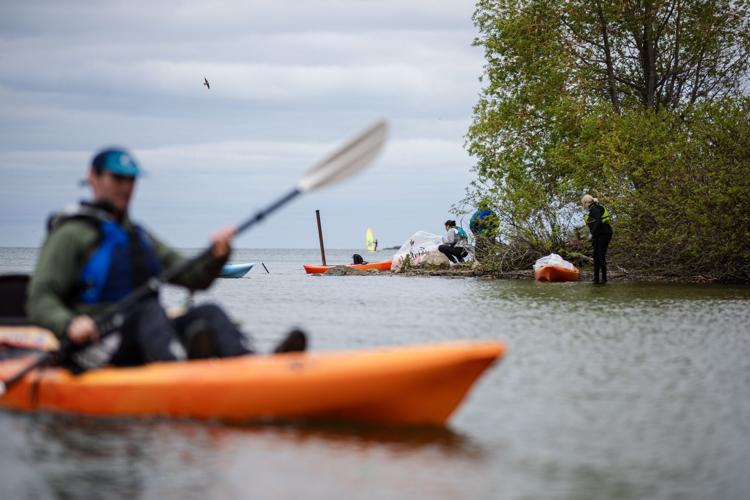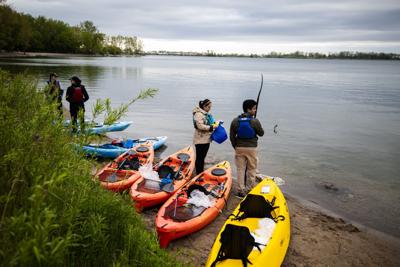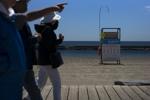Recycling bags, gloves, poker sticks and pool skimming nets without poles — not the usual list for a kayaking trip — unless, like this group assembling on the edge of Lake Ontario, your plan is to leave the water and shoreline cleaner than you found it.
Since 2018, Don’t Mess with the Don has organized land and shoreline cleanup events in ÎÚÑ»´«Ã½, organized by Lawrence Warriner, of the volunteer-led non-profit that works to clean and protect the Don Valley and ÎÚÑ»´«Ã½ ravine system.

Raul Mejia consolidates trash bags after volunteers return to Cherry beach during a shoreline cleanup.Â
Nick Lachance ÎÚÑ»´«Ã½ StarIt isn’t rare for thousands of pounds of trash to be collected in a single day of an onshore cleanup, said Warriner, adding the events are just as much about building community as they are about cleaning up earth and lake water.
Using kayaks for shoreline cleanups makes it possible to collect garbage that has blown far into the lake, carried out by waves or dropped by boaters.

Volunteers with Don’t Mess with the Don take to the water at Cherry beach to do shoreline cleanup.Â
Nick Lachance ÎÚÑ»´«Ã½ StarVolunteers from the The U of T Trash Team, a science-based organization working to increase waste literacy, and the ÎÚÑ»´«Ã½ Nature Stewards, who care for ÎÚÑ»´«Ã½â€™s ravines through an agreement with the City of ÎÚÑ»´«Ã½ Urban Forestry Division, worked as a land crew sorting the trash found, while other scavengers in kayaks out on the lake scoured the water and rocks for garbage.Â
Joining them for a recent shoreline clean up event at Cherry Beach, I fastened my life-jacket and shoved my mini waterproof notebook and pen into my chest pocket. Armed with a paddle and recycling bag, I placed my already sandy water-shoes in the open-top kayak and pushed off.
I grew up kayaking in fast moving, shallow rivers throughout Bruce County, and Ottawa and even once in Switzerland, but very seldom have I kayaked deep, cold lakes far from shore.Â
The wind was wild, the front of the kayak was lifting and crashing back down, breaking on the tops of waves and sending cold water sloshing in from all sides. My first thought? These volunteers are hardcore.Â

Lawrence Warriner organizer of Don’t Mess with the Don leads a group of volunteers onto Lake Ontario from Cherry Beach for a shoreline cleanup.Â
Nick Lachance ÎÚÑ»´«Ã½ StarWhile still shallow, I wriggled into my vessel and worked to steady myself. I could hear paddling tips being yelled to the group over the sounds of waves and wind, from Warriner, our seemingly fearless leader.
I quickly learned that spotting garbage from a kayak and securing it from a kayak were two distinctly different things. I bobbed in the water, struggling to reach items while still holding my paddle. At one point, out of the corner of my eye I spotted a small piece of floating plastic — an old lollipop stick someone had chewed one end of before the debris made its way to me, all this way from shore.

A volunteer picks up part of pool noodle with a kayak paddle while searching for trash along the shoreline at Tommy Thompson Park during a cleanup.
Nick Lachance ÎÚÑ»´«Ã½ StarThe kayakers, clearly dedicated and determined to collect the trash they spot, worked together to get hard-to-reach places. The trash does not always release easily.
At one point I found myself out of my kayak balancing on wet mossy rocks while wrestling with a piece of orange plastic from a construction site that had been lodged under boulders in the shoreline adjacent to Tommy Thompson Park.Â

Volunteers from Don’t Mess with the Don move across the outer harbour to Tommy Thompson Park during a shoreline cleanup.Â
Nick Lachance ÎÚÑ»´«Ã½ StarInvesting a matter of minutes dedicated to cleaning one section of land and then another — lifting each and every piece of yucky, brightly coloured garbage the eye could see, felt surprisingly rewarding. It only took securing a few pieces of trash into my bag for me to feel as if I was in the world’s best scavenger hunt.
Pen lids, cigarette butts, kitchen sponges, plastic bottle caps, pieces of glass, rusted metal and even shreds of paper were all items I collected without moving my feet — everything was in an arm’s reach and the longer I looked, the more I found that didn’t belong there.

A lot of the trash volunteers come back with is hard to reach or stuck between heavy rocks, making it a challenge to clean up once spotted.Â
Nick Lachance ÎÚÑ»´«Ã½ StarLooking back and seeing the difference between when I showed up to a spot versus left it, I felt pride at how my seemingly tiny actions genuinely made a difference — it was right there before my eyes, garbage that needed cleaning, quickly became garbage that was no longer there and in a city of millions of people, that felt like something meaningful.
One volunteer found an entire Adirondack chair, another found a wooden paddle, another a used needle.

Trash collected during a shoreline cleanup, including a wooden paddle at Cherry Beach.Â
Nick Lachance ÎÚÑ»´«Ã½ StarI pulled from the lake: ripped tarps, a tupperware lid and a surprisingly unsettling number of dental floss handles. It’s amazing to see the garbage that ends up in the lake that was likely never used along the shore. I have never seen anyone flossing at the beach and yet by the sheer number of flossy handles found floating, it seems the practice could arguably be one of ÎÚÑ»´«Ã½nians’ favourite pasttimes.Â
One item I found, a lost boat-bucket, came in handy when high waves splashed into my kayak and I relied on it to bail me out, a perfect reuse and recycle opportunity, just floating out in the middle harbour of Lake Ontario.

Lawrence Warriner, organizer of Don’t Mess with the Don pauses while searching for trash on the shoreline of Tommy Thompson Park during a cleanup.Â
Nick Lachance ÎÚÑ»´«Ã½ StarAt one point, while all the volunteers were rallying hard to paddle against the wind to get to another shoreline, there was movement on the rocks — something small, scurrying and poking its head up — a baby muskrat disappeared into the crevices of the rocks, just as quickly as it had shown up.
Hyper aware these rocks were home to a muskrat’s family made me all that more determined to ensure it was trash free. Another volunteer and I tackled the section by removing plastic bags, bottles, styrofoam, a decaying paint roller, a slimy tennis ball and a perfectly intact, floating golf ball.
As a group, we paddled against the wind back to shore, carrying loads of debris to be sorted, knowing each item brought onto land was one less piece of garbage leaching into Lake Ontario.

Members of the UofT Trash Team; Ashlyn Nance, Brenda Li, and Ferny Solis.
Nick Lachance ÎÚÑ»´«Ã½ StarBrenda Li, a lab co-manager with the U of T trash team and kayaking volunteer, said one of the more concerning parts of finding trash in the lake is knowing that the plastics and particles are leaching into the water itself. Li said, if we can change our habits enough to avoid using some of these items, like opting for a reusable mug or water bottle over a single-use, disposable one, we are eliminating opportunities for items meant for the trash to end up in the lake or washing up on shore.Â

Volunteers from Don’t Mess with the Don and the UofT Trash team take to the water at Cherry beach to do shoreline cleanup.Â
Nick Lachance ÎÚÑ»´«Ã½ StarBack on dry land, we helped each other carry kayaks up from the beach. Warriner offered volunteers slices of banana bread as we started to warm up.
The camaraderie was clear — those who didn’t come with friends seemed to be leaving with some.
To learn more about Don’t Mess with the Don or how to volunteer with the group





































To join the conversation set a first and last name in your user profile.
Sign in or register for free to join the Conversation